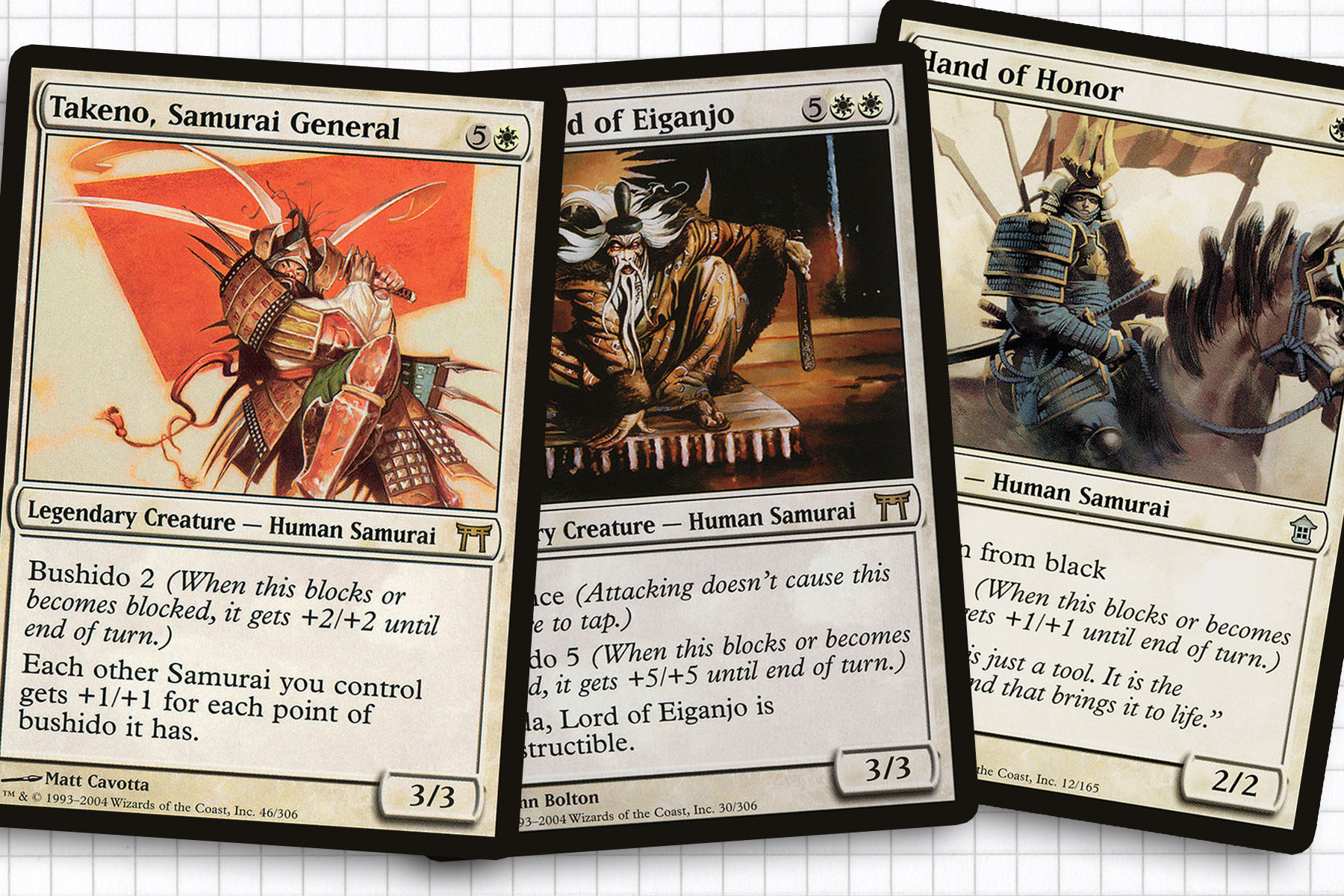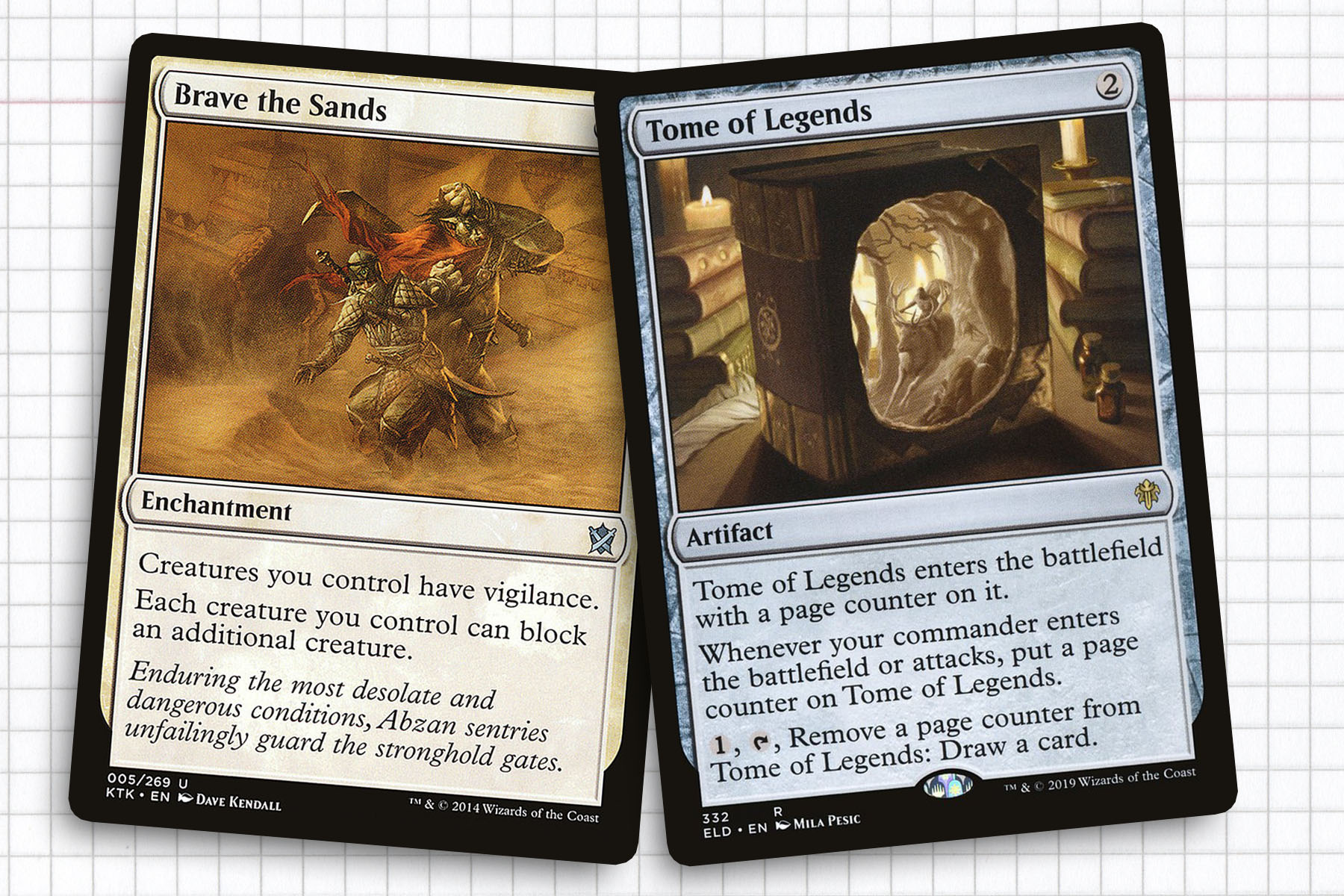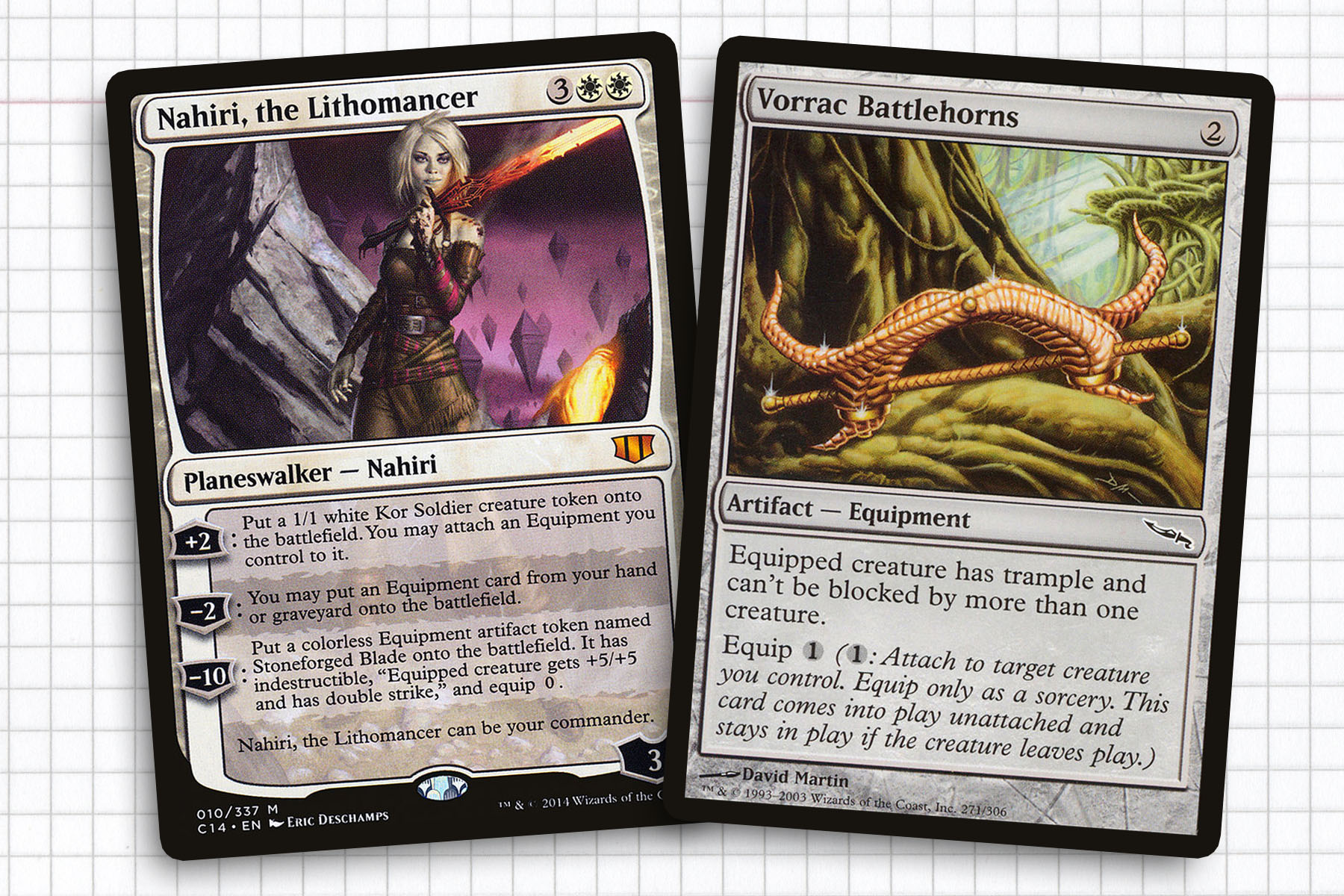I think I’ve developed a recency bias when it comes to writing lately. Looking back at the last two months, I realized it’s been very Commander product focused. To be fair, that highlights how well Commander products have been designed over the last ten years. But to mix it up some, I wanted to take a step back and examine a deck that wasn’t built on the highly optimized, value engine world where we currently live.
That brings me to a deck that I have been developing for a while without ever finishing. Until today. This week let’s talk about a monocolor general buillt around a creature type I have loved for many years—samurai. Today I am finally publish my Konda, Lord of Eiganjo deck
The reason I have been so hesitant to ultimately finish this deck has to do a lot with the adversity that samurai face in Magic. Samurai were printed back when creatures were not considered the best thing you could be doing in Magic. They were a part of a block (Kamigawa) that followed a very broken Standard (Mirrodin). Creatures were weaker in a world designed to be safe and new-player-friendly. This ultimately means that while I believe a deck built around samurai is viable, concessions need to be made to make sure that they have the tools to level the playing field, so that they can go toe-to-toe with the creatures of current-day Magic.
Commander: Konda, Lord of Eiganjo
Creatures: Araba Mothrider, Avian Changeling, Bastion Protector, Devoted Retainer, Hand of Honor, Impostor of the Sixth Pride, Indebted Samurai, Inner-Chamber Guard, Irregular Cohort, Kentaro, the Smiling Cat, Kitsune Blademaster, Konda’s Hatamoto, Mentor of the Meek, Metallic Mimic, Mirror Entity, Nagao, Bound by Honor, Reveillark, Samurai Enforcers, Sensei Golden-Tail, Stonehewer Giant, Takeno, Samurai General, Universal Automaton, Valiant Changeling
Enchantments: Authority of the Consuls, Brave the Sands, Cathars’ Crusade, Commander’s Insignia, Force of Virtue, Grasp of Fate, Shared Triumph, Sigarda’s Aid, Smothering Tithe, True Conviction, Unquestioned Authority
Artifacts: Bloodforged Battle-Axe, Coldsteel Heart, Corrupted Grafstone, Endless Atlas, Fellwar Stone, Hammer of Nazahn, Konda’s Banner, Mace of the Valiant, Masterwork of Ingenuity, Mind Stone, Oathkeeper, Takeno’s Daisho, Shadowspear, Sol Ring, Swiftfoot Boots, Tome of Legends, Vorrac Battlehorns
Planeswalkers: Ajani Steadfast, Nahiri, the Lithomancer, Serra the Benevolent
Sorceries: Austere Command, Mass Calcify, Open the Armory, Steelshaper’s Gift, Temporary Truce, Winds of Abandon
Instants: Debt of Loyalty, Teferi’s Protection
Lands: 25 Plains, Blighted Steppe, Cryptic Caves, Drifting Meadow, Emeria, the Sky Ruin, Geier Reach Sanitarium, Kabira Crossroads, Mikokoro, Center of the Sea, Mistveil Plains, New Benalia, Path of Ancestry, Secluded Steppe, Windbrisk Heights

Way of the Warrior
Before I could finish building this samurai deck, I had to accept that the overall power level was going to be lower than a deck built around a more modern general. This isn’t a problem for me, as I have found that Konda, Lord of Eiganjo—an indestructible creature with vigilance—can win games by himself against an unprepared opponent. Beyond that, the deck plays like a scaled-up version of white weenie.
Part of the fun of going hard into the samurai tribe is that you’re going to be playing with a lot of creatures you’d never play normally and opponents will have scant experience playing against. Samurai lend themselves to combat; their marquee ability (bushido) requires attacking or blocking, but the flexibility of the effect provides samurai a level of versatility we don’t often see anymore. Decks that are combat-focused but not dominant have always attracted me. What can I say, I like going off the beaten path.
The flavor and style of samurai make this deck fun. Maybe it’s the callback to White Knight or the stellar art, but Hand of Honor is one of my favorites. Protection from black comes up more often than you might expect, making it a wonderful deterrent in a format overrun with multicolored creatures. Indebted Samurai is another standout; it tells a story through its mechanics, and I love it for that.
Nearing our top end, Nagao, Bound by Honor and Takeno, Samurai General really bring the tribe to life. Promoting attacking and leveling up our battlefield, respectively, they are unconventional lords for a bygone era. Yes, Takeno is at his best with Sensei Golden-Tail in play to help bolster any forces we’d have in play, but that’s the deal when you sign up with samurai.

Leveling the Playing Field
Once the rest of the table gets over the novelty that we’re playing samurai tribal, we need to be prepared to address the fact that we’re not playing with the same caliber of cards. You will never be asked to pull your punches with a deck like this, so I’ve tried to refine the most effective suites of cards to level the playing field. We need to look like a competent threat, after all.
One of my biggest concerns was making sure we committed room to mana ramp and card draw. The ramping was simple enough: make sure Smothering Tithe is in there and then start grabbing any reasonable mana rocks that cost two or less. This meant that even Coldsteel Heart and Corrupted Grafstone were making the cut. Card draw, I’m actually not entirely happy with, only having Endless Atlas, Mikokoro, Center of the Sea, and Tome of Legends as repeatable sources of card advantage. But this is a weakness I have already identified, so future additions could solve that—perhaps Wizards will continue to print white card draw like Mangara, the Diplomat.
The next step is to stock up on effects that buff all our creatures at once. I’m admittedly a little hesitant to include Commander’s Insignia, because being realistic, you’re often not going to cast your general more than twice. But with Konda, it’s possible that I will never lose my general. I do think that the potential is there, even if Insignia turns out to be Glorious Anthem. More assuredly, Cathars’ Crusade and True Conviction are proven staples for white decks, and I believe Brave the Sands may be the best card in the deck.

The Armory
White’s interaction with equipment will be the saving grace for this deck. In crafting my list, I tried my best to take cues from the Commander 2014 deck headlined by Nahiri, the Lithomancer and the upgrades I would make to a list launching off from that. I worked from there while staying mindful not to compromise the intent of featuring samurai—Open the Armory and Stonehewer Giant were easy additions. Sigarda’s Aid, on the other hand, is a card that requires minimal investment for a great pay off, yet I feel doesn’t get included in enough decks.
For our general, Shadowspear and Vorrac Battlehorns grant trample, and Mace of the Valiant can sit out in play before being equipped to make for easy commander damage wins. For the rest of our creatures, Bloodforged Battle-Axe is ideally costed to get into combat early, making copies of itself, and increasing our threat level. While not combining with Konda well, Hammer of Nazahn turns our other creatures into miniature versions of our general, allowing them to threaten opposing forces a bit easier. And lastly, the most flavor-appropriate equipment in the deck, Oathkeeper, Takeno’s Daisho. Oathkeeper is close to a free Nim Deathmantle for samurai, giving the deck extra staying power.
I say this just about every time, but I think samurai are an interesting creature type and a nice change to the usual creature classes that run the gambit. They could be swapped in to fill the role in a world representing a skilled combat profession. I’m a little blown away at this point that we haven’t returned to the tribe, considering how many times we’ve seen ninja since Kamigawa. But overall I like playing with suboptimal cards and this is a deck that certainly highlights that.
I have nostalgia for the days where we used to play with cards that were higher up on the mana curve. Games moved a little bit slower, and you had the ability to mess around before ultimately assembling a win condition. But I’m willing to trade that feeling for a format people love. While I advocate that people consider playing Commander at a lower power level, I’m not going to stand in the way of anybody having their fun.
Ryan Sainio is a Graphic Designer who writes about EDH and the EDH community. He has been playing Magic: The Gathering since 7th Edition in 2002 and values flavorful and fun gameplay over competitively optimized decks.

